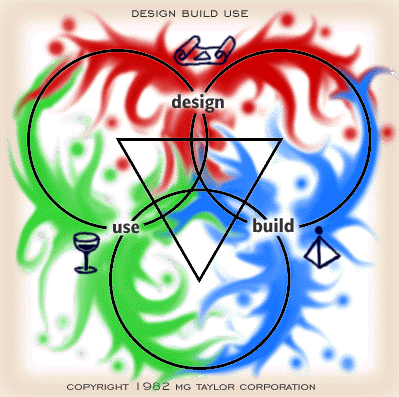|


From the Archives...
06/25/1997
Notes on Design
[Extracted from The Manual, not dated, but circa
1982, probably produced in Boulder, Colorado by Taylor Associates, Inc.
[Editor's Note: The idea of design
serves as one of the principal foundations of the MG Taylor philosophy.
Design differs from other methods in some of the following ways:
-
Design is an infinite game vs a finite
game: players engage with each other for the purpose of continuing
the play, not in order to win. There is no such thing as win-win because
the term "win" implies--demands--a "lose." Winning
is a foreign concept in design.
-
Design is a non-zero-sum game (a different
way of saying it's an infinite game). Instead of focusing on dividing
up the board or the pie between competitors or collaborators, the
players spend time creating more board and changing the rules.
-
Design comes in two stages: creating the problem
and then solving it.
-
Success in design depends upon iterations instead
of taking one shot at a solution. The vision is constantly re-created.
This is different than contingency planning.
-
Design combines options in order to eliminate
them; other methods choose between or prioritize options in order
to eliminate them. An MG Taylor axiom illustrates the principle: "Adding
someone else's experience to your experience--creating a new experience--is
possibly valuable." Another term of art employed by MG Taylor
to express the concept is "AND." Alignment is created not
by consensus or majority vote, but by recasting the vision into a
viable solution that includes as many vantage points and options as
possible.
Design
"To mark out." A design establishes the boundaries within which
an idea or conception is brought into reality by action. The design boundaries
become more "tightly" defined and precisely delineated each
step of the design formation: program, schematic concept, preliminary
design, design development, contract documents, production management,
and evaluation.
 Design-Build-Use Cycle Design-Build-Use Cycle
Presently we separate design, production and using, thereby minimizing
cooperation and feedback between what are, in fact, three stages
of one cycle. Much gain in productivity can be accomplished by
managing the "no man's land" between the established
professional enclaves centered on the "stages" of this
cycle. The complexity of the problems caused by our habit of taking
a "parts" view, will soon require that we see and manage
the Design-build-use
cycle as a total system in all areas of human activity.
Decision by Design
Traditional decision-making procedures rely extensively on the data being
complete and accurate and the logic of the decision process being faultless.
In organizations, this tends to support authority and credibility based
on past accomplishments while discounting new information and ideas. The
traditional decision-making procedure tends to go through the process
once, in a linear manner, and tries to establish a "permanent"
answer. Decision by Design is a commitment to go through the design process
again and again while "reality testing" the parts as they emerge
and get applied "in the field." If the process of design is
properly managed and comprehensively approached then inappropriate design
assumptions and decisions "fall away" leaving--from the number
of choices originally perceived--the final design most fit for use. Decision
by design is best accomplished in a Management Center environment, utilizing
DesignTeams working through a managed yet open-ended process. Specific
tools are essential, such as use of Zwicky Box analysis, and careful facilitation
and documentation. because of educational and cultural bias, at first,
Decision by Design is an uncomfortable concept to the manager; yet it
is merely a formalization of the decision method we all use in many informal
circumstances, and all complex or long-range projects. Decision by Design
requires direct and fast feedback from the field--the design process is
not completed until the project is complete. While requiring an up front
time investment, Decision by Design imposes, long term, a far smaller
management burden than the traditional decision process.
Design Strategy
The overall approach to solution seeking; used in conjunction with performance
specifications it prevents design compromise by allowing the maximum amount
of flexibility throughout the design-build-use process. The specific design
solution emerges as a result of the process, not as a preconceived notion
that everything that follows is forced into. A design strategy can be
called a design of a design.
Design Trade-off
As opposed to design compromise where the result is less than the resources
allow, a design trade-off involves the balancing of opposing attributes
within a context established by a clear mission statement. For example,
the trade-offs between speed, gas mileage, comfort, load capacity, luxury
and cost in an automobile design can only be determined within the context
of the intended use and market and the manufacturer's technical capacity
at the time of manufacture. Establishing adequate design trade-off models
is possible only with exact performance specifications.
 
copyright © 1997, MG Taylor Corporation.
All rights reserved
copyrights,
terms and conditions
19970625104351.web.bsc
|

